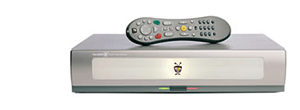|
|
 |
Knowledge Is Key
For Intelligent Decisions
Satellite Logic is a leading,
authoritative source of information in
the Satellite Industry. Located in the
heart of the Silicon Valley, Satellite
Logic provides one of the most
valuable and comprehensive
knowledge bases on the Satellite
market! This is a primary Worldwide
information center which enables our
clients to analyze, evaluate, inquire
and select their best tailored
solutions. Our company sets the
industry standards for targeted
buying leads, reflecting a dramatic
advance over traditional marketing
solutions.
|
|
|
 |

The DVR - Digital Video Recorder, also known as a "personal video
recorder" (PVR), is a consumer device that digitizes broadcast or
cable TV onto a hard disk and plays it back immediately, allowing the
viewer to pause at any time and return later. Using hardware-based
MPEG-2 compression like DVD movies, it also records programs for
later viewing just like a VCR. Using a phone line, the DVR can call a
service provider and download the channel guide updates as well as
software updates for the unit itself. The DVR can also be set to
periodically record favorite shows whenever they are broadcast.
The DVR is is connected to the various electrical equipment through
a series of jacks on the back of the box. The DVR has a built-in tuner
which intercepts the television signal via antenna, cable or satellite.
Whenever the signal comes in via antenna or cable, it is routed into
a MPEG-2 encoder. This encoder functions to convert the analog data
to digital data. After passing through the encoder, the data is sent to
the hard drive (for storage) and to an MPEG-2 decoder. The decoder
functions to convert the digital signal back to analog. Following the
conversion, the signal is finally sent to the television.

DVRs are driven by various operating systems. TiVo, for example, is
driven though the use of a modified version of Linux, stored on the
hard disk. On the hard disk - recording space, a buffer, and space for
expansion are incorporated.
It is claimed that DVRs such as TiVo allow the user to pause live TV
and then watch it in slow motion. While this is true in essence, it is
not the whole truth of the matter. When the user hits the "pause"
button, the DVR comes into the play, freezing the picture on screen
while continuing recording the program onto its hard drive. When the
user hits the "play" button again, the DVR simply plays back the material
is had recorded while the "pause" button was depressed. While doing
this, it continues to record the rest of the programming, and plays it
back in sequence. This gives the user the impression that live television
had been paused, when in fact this was not the case. The DVR is
analogous to the VCR, but with a difference. While the VCR is simply
a recording tool (the cassettes are the recording media), the DVR is
both the recording tool and the recording media all in one. DVR is much
better than a VCR, mainly because the all digital technology which
delivers improved picture quality. No tapes are required, and it's easy to
program.
|
|
|
|
